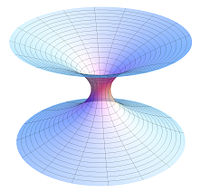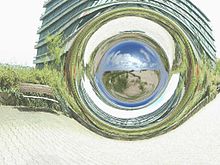虫洞
| 本条目需要擴充。(2017年7月11日) |

蟲洞在二維環境的模擬

另一種蟲洞在二維環境的模擬
蟲洞(英语:wormhole)[1],又稱愛因斯坦-羅森橋(英语:Einstein—Rosen bridge),是宇宙中可能存在的连接两个不同时空的狭窄隧道。蟲洞是1916年奥地利物理学家路德维希·弗莱姆首次提出的概念[2],1930年代由爱因斯坦及納森·羅森在研究引力场方程时假设黑洞与白洞透过虫洞连接,认为透过虫洞可以做瞬时间的空间转移或者做时间旅行。迄今为止,科学家们还没有观察到虫洞存在的证据,一般认为这是由于很难和黑洞相区别。
為了與其他種類的蟲洞進行區分,例如量子態的量子虫洞及弦論上的虫洞,一般通俗所稱之「蟲洞」應被稱為「時空洞」,量子態的量子虫洞一般被稱為「微型虫洞」,兩者有很大的區分。
黑洞有一個特性,就是會在另一邊得到所謂的「鏡射宇宙」。愛因斯坦並不重視這個解,因為我們根本不可能通行。於是連接兩個宇宙的「愛因斯坦—羅森橋」被認為只是個數學伎倆。
但是,在1963年時,紐西蘭的數學家羅伊·克爾的研究發現,假設任何崩潰的恆星都會旋轉,則形成黑洞時,將會成為動態黑洞;史瓦西的靜態黑洞並不是最佳的物理解法。然而,實際上恆星會變成扁平的結構,不會形成奇點。也就是說:重力場並非無限大。這使得我們得到了一個驚人的結論:如果我們將物體或太空船沿著旋轉黑洞的旋轉軸心發射進入,原則上,它可能可以熬過中心的重力場,並進入鏡射宇宙。如此一來,愛因斯坦—羅森橋就如同連接時空兩個區域的通道,也就是「蟲洞」。
理论上,虫洞是连结白洞和黑洞的多维空间隧道,是无处不在,但转瞬即逝的。不过有人假想一种奇异物质可以使虫洞保持张开。也有人假设如果存在一种叫做幻影物质(Phantom matter)的奇异物质的话,因为其同时具有负能量和负质量,因此能创造排斥效应以防止虫洞关闭。这种奇异物质会使光发生偏转,成为发现虫洞的訊号。但是这些理论存在过多未经测试的假设,很难令人信服[2]。
量子糾纏

洛伦兹蟲洞(史瓦西蟲洞)的電腦繪圖
將兩個黑洞糾纏在一起,然後再將它們分離,就可製成一個蟲洞連結在它們之間(基本而言,一條捷徑)。類似地從弦理論來檢視,糾纏兩個夸克也會有同樣的作用。[3][4]
這些理論結果為一些新理論提供支持。這些新理論表明,引力與它的物理性質不是基礎的,而是來自於量子糾纏。雖然量子力學正確地描述在微觀層次的相互作用,它尚未能夠解釋引力。量子引力理論應該能夠演示出古典引力不是基礎的,就如同阿爾伯特·愛因斯坦所提議,而是從更基礎的量子現象產生。[3]
施溫格效應(Schwinger effect)從真空生成的糾纏粒子對,處於電場的作用下,可以被捕獲,不讓它們湮滅回真空。這些被捕獲的粒子相互糾纏,可以映射到四維空間(一種時空的表現)。與之不同,物理學者認為,引力存在於第五維,按照愛因斯坦的定律,將時空彎曲與變形。[3]
根據全息原理(holographic principle),所有在第五維的事件可以變換為在其它四維的事件,[5]因此,在糾纏粒子被生成的同時,蟲洞也被生成。更基礎地,這論述建議,引力與它彎曲時空的能力來自於量子纠缠。[3]
參考文獻

若地面附近有一個蟲洞,它可能是這樣的[6]
^ 《何謂蛀孔》,國立交通大學官方網站[永久失效連結]
^ 2.02.1 Henry Gomm. Finding the door to a parallel universe. eurekalert. 30-Jan-2008 [2008-02-01]. 请检查|date=中的日期值 (帮助)
^ 3.03.13.23.3 You can't get entangled without a wormhole: Physicist finds entanglement instantly gives rise to a wormhole. Sciencedaily.com. 2013-12-05 [2013-12-09]. doi:10.1103/PhysRevLett.111.211603.
^ Sonner, Julian. Holographic Schwinger effect and the geometry of entanglement (PDF). Physical Review Letters. 2013, 111 (21). doi:10.1103/PhysRevLett.111.211603.
^ 'Holographic Duality' Hints at Hidden Subatomic World - Wired Science. Wired.com. 2013-07-03 [2013-12-09].
^ Flight through a Wormhole. 2008-03-13 (英语).
DeBenedictis, Andrew and Das, A. On a General Class of Wormhole Geometries. arXiv eprint server. [2005-08-12].
Dzhunushaliev, Vladimir. Strings in the Einstein's paradigm of matter. arXiv eprint server. [2005-08-12].- Einstein, Albert and Rosen, Nathan. The Particle Problem in the General Theory of Relativity. Physical Review 48, 73 (1935).
- Fuller, Robert W. and Wheeler, John A.. Causality and Multiply-Connected Space-Time. Physical Review 128, 919 (1962).
Garattini, Remo. How Spacetime Foam modifies the brick wall. arXiv eprint server. [2005-08-12].
González-Díaz, Pedro F. Quantum time machine. arXiv eprint server. [2005-08-12].
González-Díaz, Pedro F. Ringholes and closed timelike curves. arXiv eprint server. [2005-08-12].
Khatsymosky, Vladimir M. Towards possibility of self-maintained vacuum traversable wormhole. arXiv eprint server. [2005-08-12].
Krasnikov, Serguei. Counter example to a quantum inequality. arXiv eprint server. [2005-08-12].
Krasnikov, Serguei. The quantum inequalities do not forbid spacetime shortcuts. arXiv eprint server. [2005-08-12].
Li, Li-Xin. Two Open Universes Connected by a Wormhole: Exact Solutions. arXiv eprint server. [2005-08-12].- Morris, Michael S., Thorne, Kip S., and Yurtsever, Ulvi. Wormholes, Time Machines, and the Weak Energy Condition. Physical Review Letters 61, 1446–1449 (1988).
- Morris, Michael S. and Thorne, Kip S.. Wormholes in spacetime and their use for interstellar travel: A tool for teaching general relativity[永久失效連結]. American Journal of Physics 56, 395-412 (1988).
Nandi, Kamal K. and Zhang, Yuan-Zhong. A Quantum Constraint for the Physical Viability of Classical Traversable Lorentzian Wormholes. arXiv eprint server. [2005-08-12].
Ori, Amos. A new time-machine model with compact vacuum core. arXiv eprint server. [2005-08-12].
Roman, Thomas, A. Some Thoughts on Energy Conditions and Wormholes. arXiv eprint server. [2005-08-12].
Teo, Edward. Rotating traversable wormholes. arXiv eprint server. [2005-08-12].
Visser, Matt. The quantum physics of chronology protection by Matt Visser.. arXiv eprint server. [2005-08-12]. An excellent and more concise review.- Visser, Matt. Traversable wormholes: Some simple examples. Physical Review D 39, 3182–3184 (1989).
外部連結
- 香港太空館:甚麼是“蟲洞”?
- 香港太空馆:黑洞:從幻想到現實
Creating a Traversable Wormhole by Mohammad Mansouryar
What exactly is a 'wormhole'? answered by Richard F. Holman, William A. Hiscock and Matt Visser.
Why wormholes? by Matt Visser.
Wormholes in General Relativity by Soshichi Uchii.
New Improved Wormholes by John G. Cramer
White holes and Wormholes provides a very good description of Schwarzschild wormholes with graphics and animations, by Andrew J. S. Hamilton.
Questions and Answers about Wormholes[永久失效連結] a comprehensive wormhole FAQ by Enrico Rodrigo.- Wormhole on arxiv.org
[1] - Information about the theory the Large Hadron Collider could create a small wormhole. Possibly making time travel into the past possible.- animation that simulates traversing a wormhole
| ||||||||||||||||||||||||||||||
|